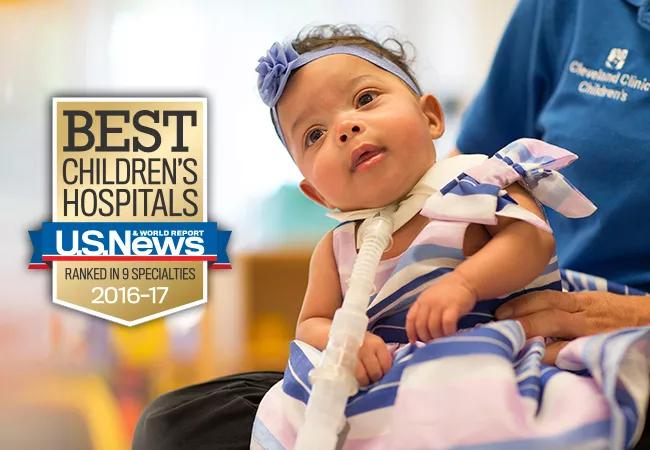Nationally ranked in 9 specialties: “Best in Northeast Ohio” in 3

This year’s U.S. News & World Report ranking of “Best Children’s Hospitals” supports Cleveland Clinic Children’s reputation as a clinical leader.
Advertisement
Cleveland Clinic is a non-profit academic medical center. Advertising on our site helps support our mission. We do not endorse non-Cleveland Clinic products or services. Policy
According to the 2016-2017 rankings of the top 50 hospitals in selected specialties, Cleveland Clinic Children’s cardiology/cardiovascular surgery program is listed #1 in Northeast Ohio and #23 nationwide. The pediatric hospital was also designated #1 in Northeast Ohio in gastroenterology and neurology/neurosurgery, and #19 nationwide in both specialties.
“This achievement validates our clinical excellence and passion for providing the best possible care for children in Ohio and throughout the nation,” said Giovanni Piedimonte, MD, chairman of Cleveland Clinic Children’s.
This year, only 78 of 180 children’s hospitals ranked in at least one specialty, and only 11 ranked in three or more. Cleveland Clinic ranked in nine.
In addition to cardiology/cardiac surgery, neurology/neurosurgery and gastroenterology, Cleveland Clinic Children’s earned national recognition in pulmonology (#23), urology (#26), orthopedics (#27), nephrology (#37), cancer (#39) and diabetes/endocrinology (#46).
An integral part of Cleveland Clinic, whose heart program has ranked #1 in the nation for an unprecedented 22 years, Cleveland Clinic Children’s is also a leader in pediatric cardiology and cardiac surgery.
In 2015, the pediatric hospital performed 147 cardiothoracic operations, 140 of which were congenital defect repairs. Five children, including one under the age of 1 year, were placed on ventricular assist devices. Seven children underwent heart transplants.
The pediatric cardiologists provided care for 8,331 outpatient visits and performed 7,114 echocardiograms and 438 cardiac catheterizations.
Advertisement
To date, their interdisciplinary Vascular Anomalies Program has achieved 100 percent success in treating more than 160 patients with infantile hemangiomas.
“Achieving this type of local and national recognition is extremely gratifying. We are proud to be among the elite in heart care,” says Hani Najm, MD, Chairman of Cleveland Clinic’s Department of Pediatric and Congenital Surgery.
The Department of Pediatric Gastroenterology serves one of the largest populations of children with digestive and hepatic disorders in the nation, caring for 8,130 outpatient visits in 2015 and performing 2,549 endoscopic procedures. The subspecialty expertise of its staff is broad and deep, and includes pediatric inflammatory bowel disease, GI motility disorders, epilepsy, syncope and intestinal rehabilitation. All aspects of liver, small bowel and multivisceral transplantation are provided.
Staff physicians regularly participate in collaborative clinics with colleagues from across Cleveland Clinic Children’s for patients with obesity, myelomeningocele, airway disease, cyclic vomiting syndrome and other conditions.
In 2015, the pediatric gastroenterologists initiated a multidisciplinary group treatment program for children struggling with encopresis or functional constipation to comprehensively address the medical, behavioral and psychological factors affecting this condition. Initial outcome data demonstrated high rates of improvement in toileting functioning and strong parent satisfaction.
In addition to expertise in treating common CNS issues and diseases, including epilepsy and syncope, many Cleveland Clinic pediatric neuroscientists have established reputations for excellence in diagnosing and treating rare and complex diseases. In 2015, advances made in by experts in pediatric multiple sclerosis and mitochondrial diseases gained national attention and were drawn into collaborative efforts to further knowledge in these diseases.
Advertisement
Cleveland Clinic Children’s offers full medical, surgical and rehabilitative care for infants, children and adolescents. The hospital has 126 beds on the main campus and 284 beds system wide. Additionally, pediatric services are available at more than 40 sites in Northeast Ohio. A staff of more than 300 full-time pediatricians and subspecialists see 750,000 pediatric visits each year and provide hospital care for 13,000 children.
Advertisement
Advertisement

HALT has unique clinical implications for adults with congenital heart disease

30-year study of Cleveland Clinic experience shows clear improvement from year 2000 onward

Check out our latest data in these core cardiovascular areas

Cleveland Clinic-pioneered repair technique restores a 61-year-old to energetic activity

How two Cleveland Clinic alliance hospitals systematically elevated echo standards

Join us in Cleveland Sept. 12-13 for latest offering of our CME-certified ‘CLE’ course

5 biggest changes according to Cleveland Clinic experts

Largest study to date confirms mortality rates similar to DBD transplant and reveals risk factors